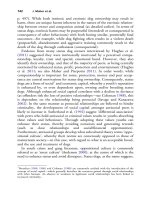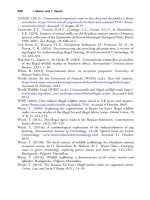The palgrave international handbook of a 281
Bạn đang xem bản rút gọn của tài liệu. Xem và tải ngay bản đầy đủ của tài liệu tại đây (27.63 KB, 1 trang )
278
K. Young
interactionism (such as the work of Goffman 1959), much of the harm
sustained by horses at the Stampede occurs not in the visible ‘front regions’ of
public sensibilities but in the ‘back regions’—away from competition, common sight and public consideration.
Theoretical Considerations
The contested nature of the Calgary Stampede and chuckwagon racing conceived of as ‘sport’ or public entertainment contains obvious potential for
critical reflection and sociological analysis. As mentioned above, figurational
sociology offers real promise because it allows for the critical study of dynamic
structures, processes and meanings that occur in a given setting. Further,
figurational approaches are effective in the study of violence (for example,
animal abuse) because they can be used to consider the relationship between
specific actions and the ‘civility’ of the wider society. Clearly, the Stampede does
not occur in a vacuum. Far from it; it is closely tied to the governance, identity,
economy and cultural history of the city of Calgary, and indeed the province of
Alberta more generally. As such, several figurational tools may be used to throw
explanatory light on harmful Stampede practices and social responses.
Referring to the conceptually central processes of ‘civilization’, Morrow
(2009) acknowledges that sport has always operated as a social barometer of
‘civility’. This theme has been developed in many figurational analyses of
sport—particularly the social-historical evaluation of violence in the evolution of activities such as soccer, foxhunting and rugby (Elias and Dunning
1986). From this point of view, links have been drawn between violence
reduction initiatives in certain sports and broader civilizing processes in
society (Morrow 2009, p. 216).
Within the sociology of sport subdiscipline, the study of sports violence
has not systematically considered the role of animals, despite the fact that
animal cruelty and violence may certainly be seen as one manifestation of
sport-related violence (Young 2012). As argued by Gerber and Young (2013)
and Young (2014), the study of animal treatment, including equine treatment, has also rarely been at the forefront of sociological research per se.
Instead, when equine events have been considered, the focus is often on how
participants operate within subcultural frameworks or how they derive
benefit from horse use in specific contexts (cf., Scott 2005).
Elias argues that as ‘ill-mannered’ and violent societies increasingly find
mechanisms to reform their laws, values and mores, a process occurs whereby
various practices which increasingly offend public sensibilities become less









